Create a Custom Annotation - WinForms C#
LEADTOOLS includes more than 30 built-in annotation objects that can be extended to create custom annotation objects. This tutorial demonstrates how to create a custom circle annotation derived from the AnnEllipseObject class in a C# WinForms application using the Image Viewer.
| Overview | |
|---|---|
| Summary | This tutorial covers both the automated and custom annotation features in a C# WinForms application using the Image Viewer. |
| Completion Time | 45 minutes |
| Visual Studio Project | Download tutorial project (3 KB) |
| Platform | WinForms C# Application |
| IDE | Visual Studio 2022 |
| Development License | Download LEADTOOLS |
| Try it in another language |
|
Required Knowledge
Before working on the Create a Custom Annotation - WinForms C# tutorial, get familiar with the basic steps of creating a project by reviewing the Add References and Set a License tutorial.
Create the Project and Add LEADTOOLS References
Start with a copy of the project created in the Add References and Set a License tutorial. If you do not have that project, follow the steps in that tutorial to create it.
The references needed depend upon the purpose of the project. References can be added by one or the other of the following two methods (but not both). For this project, the following references are needed:
If using NuGet references, this tutorial will require the following NuGet packages:
Leadtools.Annotations.WinFormsLeadtools.Viewer.Controls.WinForms
If local DLL references are used, the following DLLs are needed. The DLLs are located at <INSTALL_DIR>\LEADTOOLS22\Bin\net:
Leadtools.dllLeadtools.Annotations.Automation.dllLeadtools.Annotations.Designers.dllLeadtools.Annotations.Engine.dllLeadtools.Annotations.Rendering.WinForms.dllLeadtools.Annotations.WinForms.dllLeadtools.Codecs.dllLeadtools.Codecs.Cmp.dllLeadtools.Controls.WinForms.dllLeadtools.Drawing.dllLeadtools.WinForms.CommonDialogs.File.dll
For a complete list of which DLL files are required for your application, refer to Files to be Included in your Application.
Set the License File
The License unlocks the features needed for the project. It must be set before any toolkit function is called. For details including tutorials for different platforms, refer to Setting a Runtime License.
There are two types of runtime licenses:
- Evaluation license, obtained at the time the evaluation toolkit is downloaded. It allows the toolkit to be evaluated.
- Deployment license. If a Deployment license file and developer key are required, refer to Obtaining a License.
Note
Adding LEADTOOLS NuGet and local references and setting a license are covered in more detail in Add References and Set a License.
Initialize the Image Viewer
With the project created, the references added, and the license set, coding can begin. Right-click on Form1.cs in the Solution Explorer, and select View Code to bring up the code behind the form. Add the below code in the Using block and declare global members.
// Using block at the topusing System;using System.Drawing;using System.Windows.Forms;using Leadtools;using Leadtools.Codecs;using Leadtools.Controls;using Leadtools.Annotations.Engine;using Leadtools.Annotations.Automation;using Leadtools.Annotations.Designers;using Leadtools.Annotations.Rendering;using Leadtools.Annotations.WinForms;
// Declare these global membersprivate ImageViewer _imageViewer;private RasterCodecs _codecs;private AutomationInteractiveMode _annInteractiveMode;private IAnnAutomationControl _automationControl;private AnnAutomationManager _annManager;private AnnAutomation _annAutomation;
In the Solution Explorer, double-click Form1.cs to display it in the designer, and click on the Events icon in the Properties Windows. Then, double-click the Load event to create an event handler if one does not already exist.
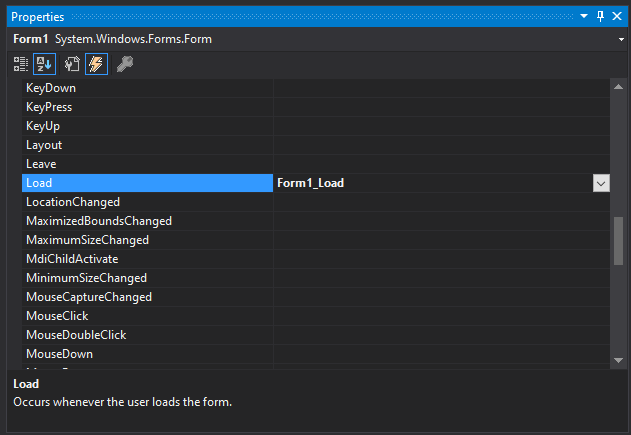
Add the following code inside the Form1_Load event handler to initialize the ImageViewer, create a new blank RasterImage, and set it in the viewer.
private void Form1_Load(object sender, EventArgs e){// Initialize the imageViewer object_imageViewer = new ImageViewer();_imageViewer.Dock = DockStyle.Fill;_imageViewer.BackColor = Color.DarkGray;Controls.Add(_imageViewer);_imageViewer.BringToFront();// Create a plain white background to draw on_imageViewer.Image = RasterImage.Create(1000, 1000, 24, 96, RasterColor.White);// Initialize the codecs object.codecs = new RasterCodecs();}
Add Toolbar Icon Resource
In the Solution Explorer, right-click the project file -> Properties
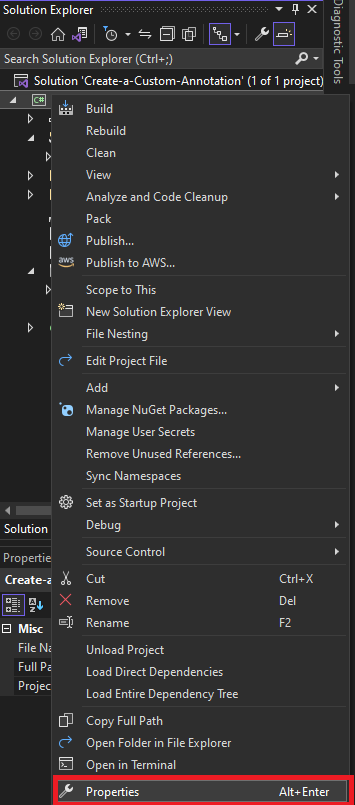
In the properties menu go to Resources -> Create or open assembly sources
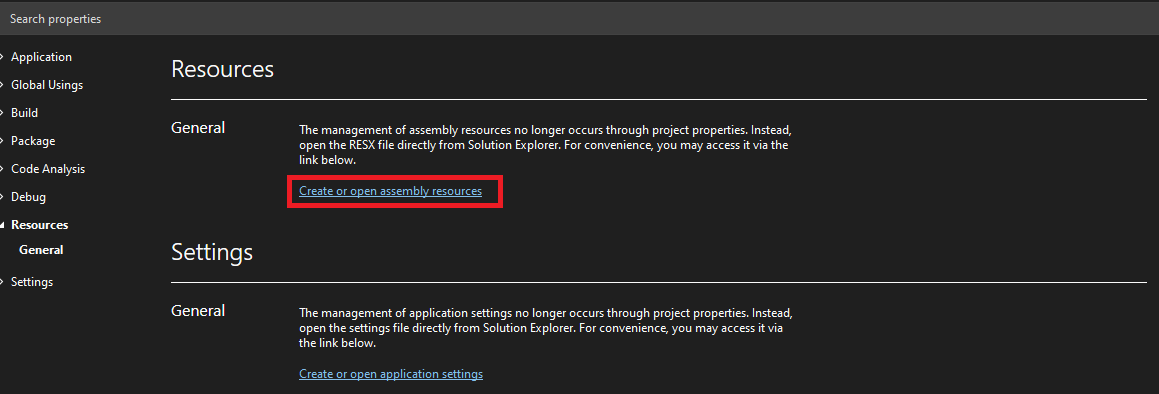
Click Add Resource and then click Add Existing File....
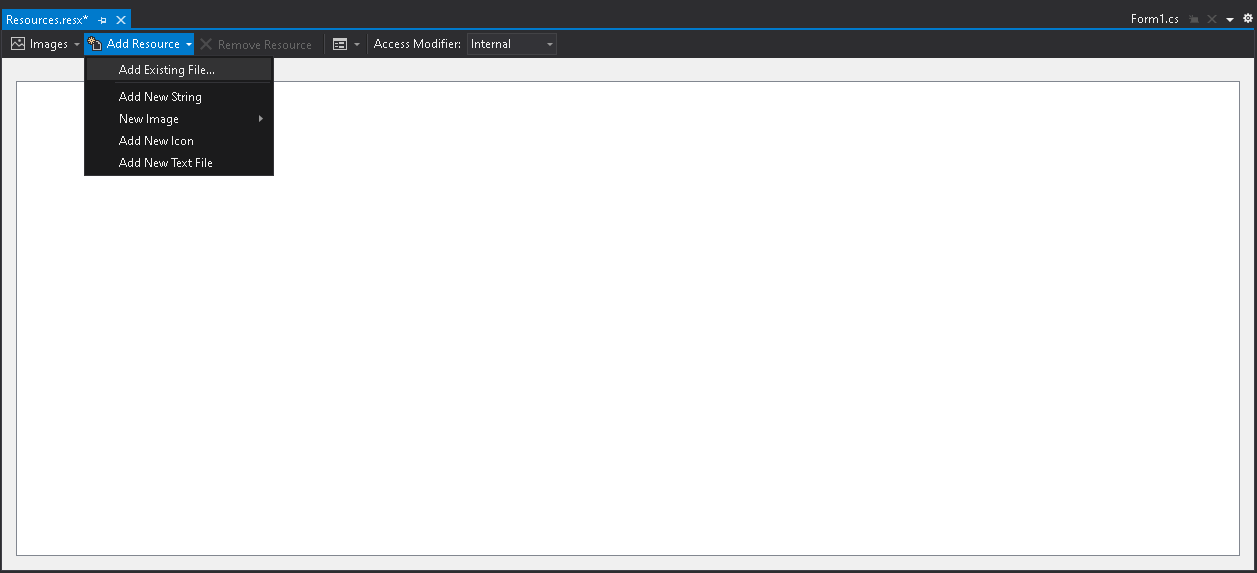
Download the Circle Icon PNG image below and browse to the location and click Open.
After the resource has been imported, the project will create a Resources folder.
This image needs to be embedded into the project. To do so, navigate to Solution Explorer, drop down the Resources folder, and click on Create-a-Custom-Annotation-Circle-Icon.png. In the properties, change Build Action to embedded resource.
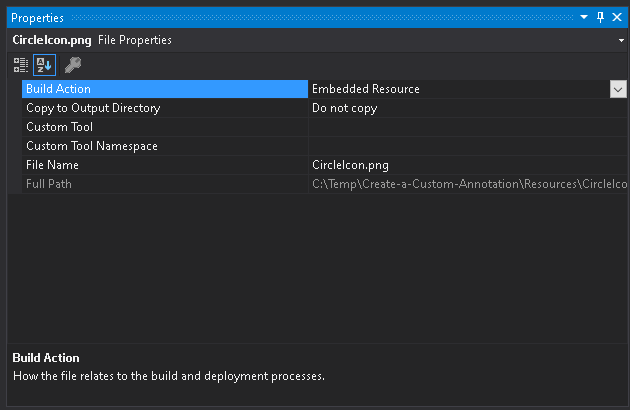
Create Custom Circle Annotation Object Classes
In the Solution Explorer, right-click the Project, highlight Add, and click Create Folder. Rename the folder to be AnnCircleObject.
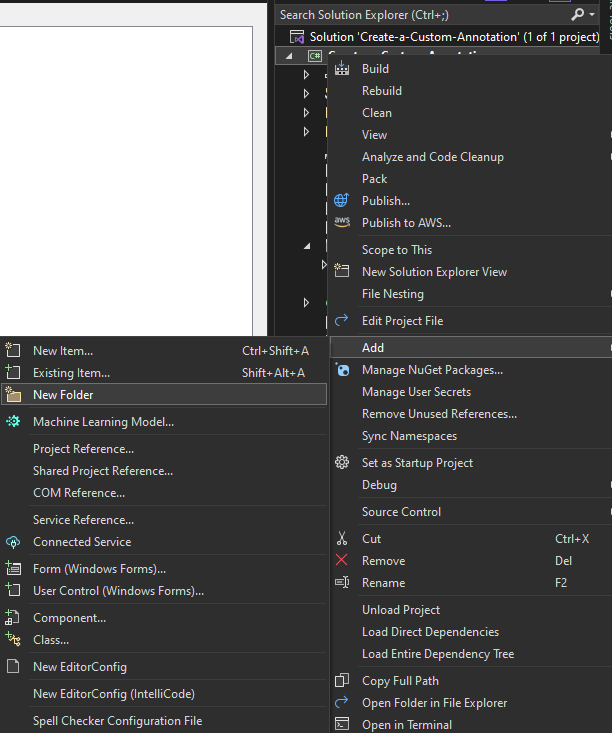
In the Solution Explorer, right-click the AnnCircleObject folder, highlight Add, and click Class....
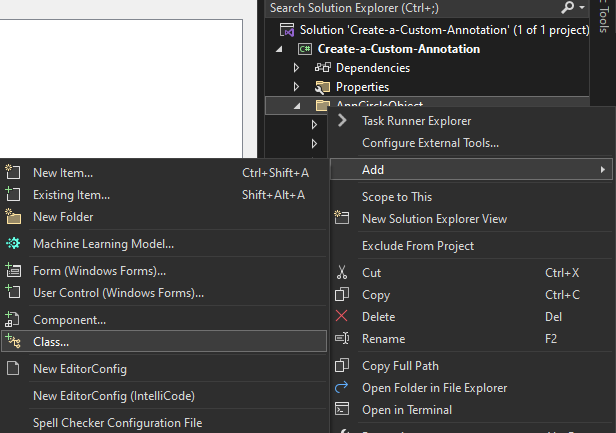
Add three new classes:
AnnCircleDrawDesigner.csAnnCircleObject.csAnnCircleObjectRenderer.cs
Note
Be sure to change the namespace for each of these classes to match the namespace in
Form1.cs.
Add the below code to the AnnCircleDrawDesigner class:
using System;using Leadtools;using Leadtools.Annotations.Engine;using Leadtools.Annotations.Designers;namespace Create_a_Custom_Annotation{class AnnCircleDrawDesigner : AnnRectangleDrawDesigner{//We need 2 points, a beginning and an ending pointprivate LeadPointD begin = LeadPointD.Empty;private LeadPointD end = LeadPointD.Empty;/// <summary>/// Constructor for the AnnCircleDrawDesigner/// </summary>public AnnCircleDrawDesigner(IAnnAutomationControl automationControl, AnnContainer container, AnnCircleObject annObject): base(automationControl, container, annObject) { }/// <summary>/// override the pointer down event/// set the beginning and ending points to the location of the first click/// </summary>public override bool OnPointerDown(AnnContainer sender, AnnPointerEventArgs e){begin = e.Location;end = begin;return base.OnPointerDown(sender, e);}/// <summary>/// override the pointer move event/// set the new mouse point to the end variable/// do some math to create a circle object (width/height stay equal)/// </summary>public override bool OnPointerMove(AnnContainer sender, AnnPointerEventArgs e){end = e.Location;AnnCircleObject circle = (AnnCircleObject)TargetObject;double x = (end.X - begin.X);double y = Math.Abs(end.Y - begin.Y);double scaleX = 1;double scaleY = 1;if (x < y)scaleX = y / x;elsescaleY = x / y;circle.Rect = LeadRectD.Create(begin.X, begin.Y, Math.Abs(end.X - begin.X) * Math.Abs(scaleX), Math.Abs(end.Y - begin.Y) * Math.Abs(scaleY));Invalidate(LeadRectD.Empty);return true;}}}
Add the below code to the AnnCircleObject class:
using Leadtools.Annotations.Engine;namespace Create_a_Custom_Annotation{class AnnCircleObject : AnnEllipseObject{//set the id to the UserObjectIDpublic const int CircleObjectId = UserObjectId;/// <summary>/// Constructor for the object/// set the id of the object to the circle object ID/// </summary>public AnnCircleObject(): base(){SetId(CircleObjectId);Tag = null;}protected override AnnObject Create(){return new AnnCircleObject();}}}
Add the below code to the AnnCircleObjectRenderer class:
using System.Collections.Generic;using Leadtools.Annotations.Rendering;using Leadtools.Annotations.Automation;using Leadtools.Annotations.Engine;using Leadtools;namespace Create_a_Custom_Annotation{class AnnCircleObjectRenderer : AnnEllipseObjectRenderer{/// <summary>/// Constructor for the renderer/// get the ellipse object renderer and use the same styles for the circle/// </summary>public AnnCircleObjectRenderer(AnnAutomationManager manager): base(){IAnnObjectRenderer annEllipseObjRenderer = manager.RenderingEngine.Renderers[AnnObject.EllipseObjectId];LabelRenderer = annEllipseObjRenderer.LabelRenderer;LocationsThumbStyle = annEllipseObjRenderer.LocationsThumbStyle;RotateCenterThumbStyle = annEllipseObjRenderer.RotateCenterThumbStyle;RotateGripperThumbStyle = annEllipseObjRenderer.RotateGripperThumbStyle;// The below snippet changes the annotation's thumbnail size//LeadSizeD newThumbSize = LeadSizeD.Create(300, 300); // New size of the thumbnails, change as necessary//LocationsThumbStyle.Size = newThumbSize;//RotateCenterThumbStyle.Size = newThumbSize;//RotateGripperThumbStyle.Size = newThumbSize;}/// <summary>/// override the RenderThumbs method/// go through the thumbs and remove the top bottom left and right thumbs so it cannot be changed from a circle/// </summary>public override void RenderThumbs(AnnContainerMapper mapper, LeadPointD[] thumbLocations, AnnFixedStateOperations operations){List<LeadPointD> newThumbs = new List<LeadPointD>();for (int i = 0; i < thumbLocations.Length; i += 2)newThumbs.Add(thumbLocations[i]);base.RenderThumbs(mapper, newThumbs.ToArray(), operations);}}}
Initialize Annotations and Create Custom Annotation Code
Right-click on Form1.cs in the Solution Explorer and select View Code to bring up the code behind the form. Add a new method, name it InitAnnotations(), and call the new method inside the Form1_Load event handler below imageViewer.BringToFront().
private void Form1_Load(object sender, EventArgs e){// Initialize the imageViewer object_imageViewer = new ImageViewer();_imageViewer.Dock = DockStyle.Fill;_imageViewer.BackColor = Color.DarkGray;Controls.Add(_imageViewer);_imageViewer.BringToFront();InitAnnotations();// Create a plain white background to draw on_imageViewer.Image = RasterImage.Create(1000, 1000, 24, 96, RasterColor.White);// Initialize the codecs object._codecs = new RasterCodecs();}
Add the following code inside the InitAnnotations() method:
void InitAnnotations(){//AnnManager initialization comes first_annManager = new AnnAutomationManager();_annManager.RestrictDesigners = true;_annManager.RenderingEngine = new AnnWinFormsRenderingEngine();//Create my custom objectsCreateCustomObject(_annManager);//create the helper and toolbar, then add them to the formAutomationManagerHelper annHelper = new AutomationManagerHelper(_annManager);annHelper.CreateToolBar();Controls.Add(annHelper.ToolBar);//create the automation control and attach the viewer to it_automationControl = new ImageViewerAutomationControl();((ImageViewerAutomationControl)_automationControl).ImageViewer = _imageViewer;//initialize the interactive mode and add it to the viewer_annInteractiveMode = new AutomationInteractiveMode();_annInteractiveMode.AutomationControl = _automationControl;_imageViewer.InteractiveModes.BeginUpdate();_imageViewer.InteractiveModes.Add(_annInteractiveMode);_imageViewer.InteractiveModes.EndUpdate();//initialize the automation_annAutomation = new AnnAutomation(_annManager, _automationControl);//whenever loading a new image, set the new size in the container_imageViewer.ItemChanged += ImageViewer_ItemChanged;_annAutomation.Active = true;}private void ImageViewer_ItemChanged(object sender, ImageViewerItemChangedEventArgs e){if (e.Reason == ImageViewerItemChangedReason.Image)_annAutomation.Container.Size = _annAutomation.Container.Mapper.SizeToContainerCoordinates(_imageViewer.ImageSize.ToLeadSizeD());}
Add a new method inside the Form1 class named CreateCustomObject(AnnAutomationManager annManager). This method is called inside the InitAnnotations() method as shown above. Add the below code to the new method:
private void CreateCustomObject(AnnAutomationManager _annManager){//create the circle object, assign the designers, set the toolbar image, and then add it to the manager and rendering engineAnnAutomationObject circleAutomationObject = new AnnAutomationObject();circleAutomationObject.Id = AnnCircleObject.CircleObjectId;circleAutomationObject.Name = "Circle";circleAutomationObject.ToolBarToolTipText = circleAutomationObject.Name;circleAutomationObject.DrawDesignerType = typeof(AnnCircleDrawDesigner);circleAutomationObject.EditDesignerType = typeof(AnnRectangleEditDesigner);circleAutomationObject.RunDesignerType = typeof(AnnRunDesigner);circleAutomationObject.ObjectTemplate = new AnnCircleObject();circleAutomationObject.ToolBarImage = new Bitmap(typeof(Form1), "Resources.Dotnet-WinForms-Create-a-Custom-Annotation-Circle.png");circleAutomationObject.ContextMenu = new Leadtools.Annotations.WinForms.ObjectContextMenu();_annManager.Objects.Add(circleAutomationObject);_annManager.RenderingEngine.Renderers.Add(AnnCircleObject.CircleObjectId, new AnnCircleObjectRenderer(_annManager));}
Run the Project
Run the project by pressing F5, or by selecting Debug -> Start Debugging.
If the steps were followed correctly, the application should run and display a blank white RasterImage. To draw the custom circle annotations, click the button on the top left of the form.
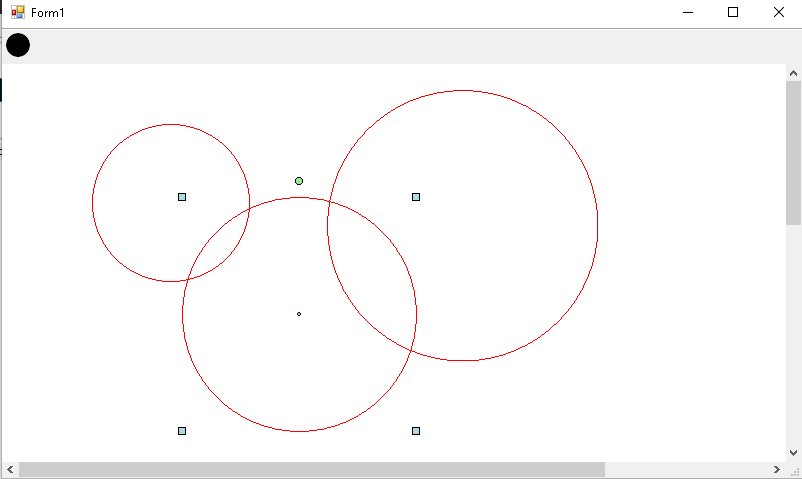
Wrap-up
This tutorial covered how to create a custom circle annotation using the LEADTOOLS Annotations SDK technology.
